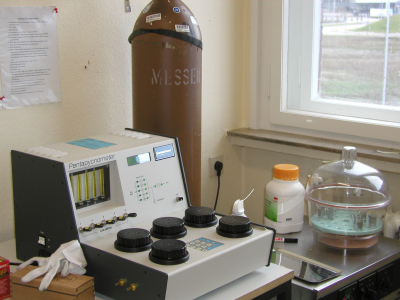Page path:
- IODP at MARUM
- Partner to the ECORD Science Operator
- Onshore Science Party (OSP)
- Core flow and procedures
- Physical Properties
- Moisture And Density (MAD)
Moisture And Density (MAD)
A spreadsheet is prepared with weight and volume for each numbered beaker and formulas to get moisture and density data from the measured mass and volume of the sample. Sampling interval is at least one per section. Numbered 10 ml borosilicate glass beakers are filled with sediment. Wet mass of sample+beaker is measured. Samples are oven dried at 105+/-5° C for 24 h and equilibrated to room temperature afterwards in a desiccator. Dry mass of sample+beaker is measured.
The pycnometer now is used to measure the dry sample volume. The instrument guides the user through the program. It is recommended to use multi run mode with a minimum of 5 runs and a run deviation 0.01%. After measurements are complete the results are downloaded to the PC and copied to the prepared spreadsheet. Beakers are emptied and cleaned in an ultrasonic bath. Conditions: Samples are measured in numbered borosilicate beakers. Samples are dried in an oven at 105 ± 5° C for 24 hours.
Calibration is performed once at the beginning (when instrument has been moved). Cell calibration is performed for each cell once before starting measurements. New cell calibration must be performed if the measured volume of the standard spheres deviates more than 0.02 ccm from the reference volume. 4 samples and one standard reference volume (one small sphere + two micro spheres) are run at the same time. The reference volume is rotating among the cells.
Maximum number of runs: 5
Run deviation: 0.02
The Bremen Penta Pycnometer for volume determinations was modified to run a high number of sediment samples. Sample plugs of coral and hard rock samples obtained with a 1-inch diameter drill were placed in aluminium beakers and carried around with trays. After oven drying for 24 hours, the plugs were weighted and put directly (without beaker) into the pycnometer chambers. Scientist who sailed on JOIDES Resolution before were surprised about the good performance of the instrument. Within 3 weeks (351 measurements) only 6 recalibrations of individual chambers became necessary. Results from the pycnometer are downloaded to the PC and copied to the prepared spreadsheet. After the dry volume measurement the sample plugs were watered in saltwater for 24 hours to obtain the wet weight.
The pycnometer now is used to measure the dry sample volume. The instrument guides the user through the program. It is recommended to use multi run mode with a minimum of 5 runs and a run deviation 0.01%. After measurements are complete the results are downloaded to the PC and copied to the prepared spreadsheet. Beakers are emptied and cleaned in an ultrasonic bath. Conditions: Samples are measured in numbered borosilicate beakers. Samples are dried in an oven at 105 ± 5° C for 24 hours.
Calibration is performed once at the beginning (when instrument has been moved). Cell calibration is performed for each cell once before starting measurements. New cell calibration must be performed if the measured volume of the standard spheres deviates more than 0.02 ccm from the reference volume. 4 samples and one standard reference volume (one small sphere + two micro spheres) are run at the same time. The reference volume is rotating among the cells.
Maximum number of runs: 5
Run deviation: 0.02
The Bremen Penta Pycnometer for volume determinations was modified to run a high number of sediment samples. Sample plugs of coral and hard rock samples obtained with a 1-inch diameter drill were placed in aluminium beakers and carried around with trays. After oven drying for 24 hours, the plugs were weighted and put directly (without beaker) into the pycnometer chambers. Scientist who sailed on JOIDES Resolution before were surprised about the good performance of the instrument. Within 3 weeks (351 measurements) only 6 recalibrations of individual chambers became necessary. Results from the pycnometer are downloaded to the PC and copied to the prepared spreadsheet. After the dry volume measurement the sample plugs were watered in saltwater for 24 hours to obtain the wet weight.
Pycnometer Measurement Guidelines
- Put sample and reference volume (spheres) into pycnometer cells and write cell numbers on logsheet.
- Press 1 for RUN.
- Select cell number.
- You are asked for cell size. Press 2 for medium and ENTER.
- You are asked for the weight. This is not relevant. Type e.g. 1 and press ENTER.
- You are asked for sample ID. Enter sample number or 00 for calibration spheres and press ENTER.
- You are back to the Cell selection menu. Cells selected are marked by an M (for medium). Select next cell or press enter to start measurements.
- Press 2 for Multi Run.
- Enter maximum number of runs (minimum of 5 runs are recommended). Enter number of runs to average (normally 3). Enter run deviation (0.01 % is recommended). The pycnometer will continue to measure each cell until the percent deviation of three consecutive runs is equal or less than the specified value.
- You are asked "print at end of run ?" Type 2 for NO.
- Enter purge mode: 1 for flow.
- Enter purge time (1 Minute).
- Press enter to start.
- When pycnometer is ready "Run completed" is shown on display. You can review the results by pressing REV. In case the measured reference spheres give a volume that deviates by > 0.02 from the reference volume (9.2144 ccm) perform a cell calibration.
- Start program pycwin on PC and click blue flash for data aquisition.
- Enter operator and Sample ID (Spheres for calibration spheres).
- Press UP at the pycnometer for upload. Enter cell number to upload.
- Press proceed to upload at PC.
- Press enter on Pycnometer.
- File will be uploaded. Print results. Repeat upload for other cells.



